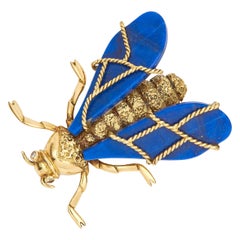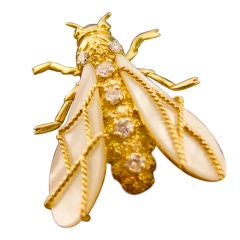Chaumet Fly
Recent Sales
Vintage 1970s English Modern Brooches
Diamond, Lapis Lazuli, Gold, 18k Gold, Yellow Gold
Vintage 1960s Brooches
Diamond, 18k Gold
Chaumet for sale on 1stDibs
Decades before luxury French jewelry maisons such as Van Cleef & Arpels and Cartier were born, Marie-Étienne Nitot (1750–1809) founded the house that became the internationally esteemed Chaumet, which, for centuries, has created timeless necklaces, watches, rings, tiaras and other jewelry and accessories for royalty as well as Hollywood luminaries.
Before opening his own jewelry house, Nitot worked as an apprentice to Ange-Joseph Aubert, court jeweler to Marie Antoinette, and collaborated on pieces for the Queen. In 1780, he left Aubert’s side to open his own maison.
Surviving the upheaval of the French Revolution, Nitot soon found lavish commissions with the new people in power. The Emperor Napoléon Bonaparte longed for France to once again be the epicenter of luxury, making himself the fashionable face of the prospering country. Nitot’s commissions for Napoléon began with the papal tiara for Pope Pius VII that included a 414-carat emerald among its thousands of precious stones and the 1804 coronation sword, a decadent piece that featured the 140-carat Regent diamond.
The young jewelry house soon became the official jeweler of the Imperial Court, the personal jeweler of Empress Joséphine and one of the most sought-after jewelers in Europe. Chaumet’s work in this era helped popularize the tiara as a status symbol, with ornate pieces designed for Joséphine and Empress Marie-Louise, Napoléon’s second wife.
After Nitot died in 1809, his son, François-Regnault, took over in 1812 and moved the maison into the Place Vendôme, making it the first business to occupy the Parisian center of luxury. By then, Chaumet had included timepieces in its offerings, such as bracelet watches adorned with precious gemstones and equipped with movements made by Breguet (which opened a shop on Place Vendôme in 1933).
After the fall of the Napoléon Empire, successors Jean-Baptiste and Jules Fossin focused more on romantic styles of jewelry that referenced the past and nature, an approach carried on by Valentin and Prosper Morel. It was Joseph Chaumet, director from 1885 to 1928, who gave the maison its illustrious name and brought it into the 20th century with jewelry, accessories and tiaras inspired by the extravagant decor of the Belle Époque.
Later, with Joseph’s son, Marcel Chaumet, succeeding him, the house would be featured at the Exposition Internationale des Arts Décoratifs et Industriels Modernes in Paris — from which the term Art Deco derives — and, alongside the likes of Cartier, would be seen as a leader in introducing the flamboyantly geometric designs and high-contrast color pairings of Art Deco jewelry to the global stage.
Chaumet has adapted over the years to meet changing tastes and trends. The house still reigns in the world of luxury jewelry, celebrating its 240th anniversary in 2020. Since 1999, it has been part of the LVMH Group. Its salons and high jewelry workshop continue to operate in the Place Vendôme where gem-setters, polishers and jewelers craft rings, earrings, watches and enduringly popular tiaras.
Find an exquisite range of authentic vintage Chaumet jewelry on 1stDibs.
The Legacy of Diamond in Jewelry Design
Antique diamond rings, diamond tiaras and dazzling vintage diamond earrings are on the wish lists of every lover of fine jewelry. And diamonds and diamond jewelry are primarily associated with storybook engagements and red-carpet grand entrances — indeed, this ultra-cherished gemstone has a dramatic history on its hands.
From “A Diamond Is Forever” to “Diamonds Are a Girl’s Best Friend,” pop culture has ingrained in our minds that diamonds are the most desired, the most lasting and the most valuable gemstone. But what makes the diamond so special? Each stone — whether it’s rubies, sapphires or another stone — is unique and important in its own right. April babies might claim diamonds for themselves, but just about everyone wants this kind of sparkle in their lives!
There are several factors that set diamonds apart from other stones, and these points are important to our gem education.
Diamonds are minerals. They are made up of almost entirely of carbon (carbon comprises 99.95 percent; the remainder consists of various trace elements). Diamonds are the hardest gemstones, ranking number 10 on the Mohs Hardness Scale. Even its name, diamond, is rooted in the Greek adamas, or unconquerable. The only object that can scratch a diamond is another diamond. Diamonds are formed deep within the earth at very high temperatures (1,652–2,372 degrees Fahrenheit at depths between 90 and 120 miles beneath the earth’s surface) and are carried up by volcanic activity. Diamonds are quite rare, according to the Gemological Institute of America, and only 30 percent of all the diamonds mined in the world are gem quality.
In the 1950s, the Gemological Institute of America developed the 4Cs grading system to classify diamonds: clarity, color, cut and carat weight. Not all diamonds are created equal (there are diamonds, and then there are diamonds). The value of the diamond depends on the clarity (flawless diamonds are very rare but a diamond's value decreases if there are many blemishes or inclusions), color (the less color the higher the grade), cut (how the diamond’s facets catch the light, certain cuts of diamonds show off the stone better than others) and carat weight (the bigger, the better).
When you start shopping for a diamond engagement ring, always prioritize the cut, which plays the largest role in the diamond's beauty (taking the time to clean your diamond ring at least every six months or so plays a role in maintaining said beauty). And on 1stDibs, a range of buying guides can be found for those in the market for antique engagement rings, vintage engagement rings or Art Deco engagement rings.
Shop antique and vintage diamond rings, diamond necklaces and other extraordinary diamond jewelry on 1stDibs.
Finding the Right Brooches for You
Vintage brooches, which refer to decorative jewelry traditionally pinned to garments and used to fasten pieces of clothing together where needed, have seen increasing popularity in recent years.
While jewelry trends come and go, brooches are indeed back on the radar thanks to fashion houses like Gucci, Versace, Dior and Saint Laurent, all of which feature fun pinnable designs in their current collections. Whether a dazzlingly naturalistic Art Nouveau dragonfly, a whimsical David Webb animal, a gem-studded bloom or a streamlined abstract design, these jewels add color and sparkle to your look and a spring to your step.
Given their long history, brooches have expectedly taken on a variety of different shapes and forms over time, with jewelers turning to assorted methods of ornamentation for these accessories, including enameling and the integration of pearls and gemstones. Cameo brooches that originated during the Victorian age are characterized by a shell carved in raised relief that feature portraits of a woman’s profile, while 19th-century micromosaic brooches, comprising innumerable individually placed glass fragments, sometimes feature miniature depictions of a pastoral scene in daily Roman life.
At one time, brooches were symbols of wealth, made primarily from the finest metals and showcasing exquisite precious gemstones. Today, these jewels are inclusive and universal, and you don’t have to travel very far to find an admirer of brooches. They can be richly geometric in form, such as the ornate diamond pins dating from the Art Deco era, or designer-specific, such as the celebrated naturalistic works created by Tiffany & Co., the milk glass and gold confections crafted by Trifari or handmade vintage Chanel brooches of silk or laminated sheer fabric. Chanel, of course, has never abandoned this style, producing gorgeously baroque CC examples since the 1980s.
Brooches are versatile and adaptable. These decorative accessories can be worn in your hair, on hats, scarves and on the lower point of V-neck clothing. Pin a dazzling brooch to the lapel of your blazer-and-tee combo or add a cluster of smaller pins to your overcoat. And while brooches have their place in “mourning jewelry,” in that a mourning brooch is representative of your connection to a lost loved one, they’re widely seen as romantic and symbolic of love, so much so that a hardcore brooch enthusiast might advocate for brooches to be worn over the heart.
Today, find a wide variety of antique and vintage brooches for sale on 1stDibs, including gold brooches, sapphire brooches and more.

